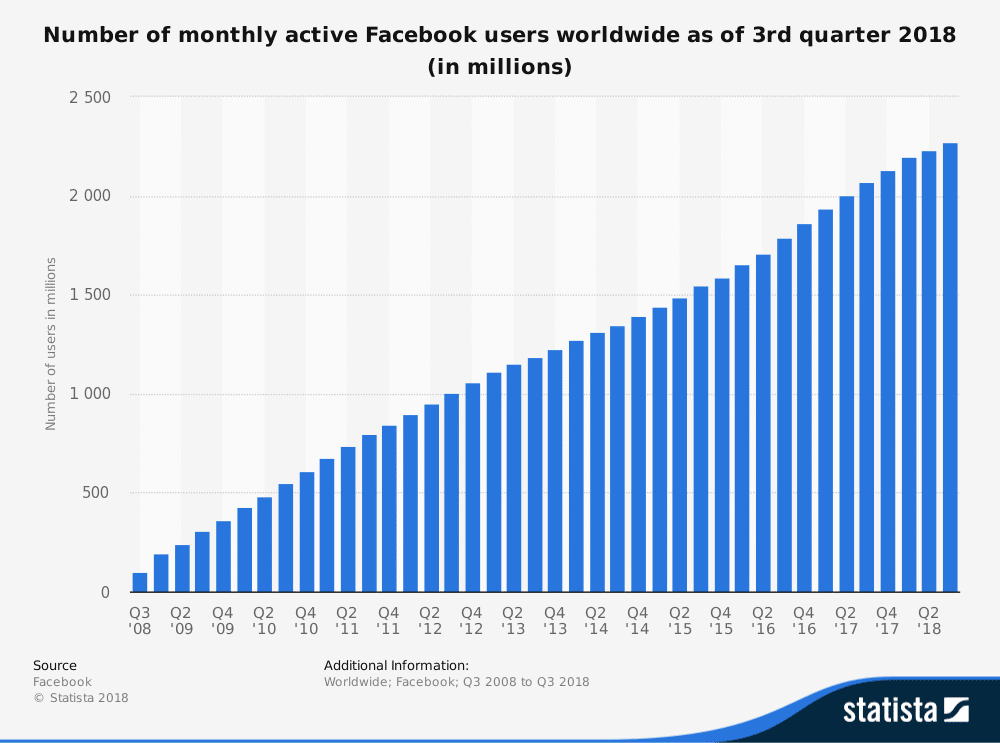Society is more demanding and less patient than ever before. Let’s not sugar coat it, consumers are expecting more from the brands they interact with.
Where it used to be a novelty for a brand to have a mobile app, it’s now an expectation.
Let’s take the cab industry as an example. Of course, we all know what happened with Uber, DiDi and the many other disruptors. Now, I can’t go longer than 15 minutes watching TV without seeing a 13Cabs ad telling viewers they have a mobile app. Yes, that’s right, occasionally I watch live TV...
We can also look to the trends of the most downloaded app in the world, Facebook, for more evidence that consumers are moving towards a mobile-first mindset.
With mobile app’s becoming the standard for companies engaging their users, there is a huge opportunity to become an industry leader if you can develop a better experience.
In order to gain all the benefits that come with a cutting-edge mobile app, you’ll first need to know the process of building an app. In a previous blog, I outlined the 10 steps to take before starting a mobile app. This article will look at the entire process more holistically so that you can leverage one of the many benefits of building a mobile app.
Step 1: Create Your App’s Strategy
Every business has a business plan. Whether it’s documented in a 200-page binder or the founder's head, there is a plan.
A mobile app is an extension of your business. As a result, it needs to have its own strategy that feeds into your business direction.
Luckily enough, we’ve created a framework for you to use for your app’s strategy.
You can view it here.
I’ll give you a little rundown of the core parts of an app strategy that we recommend. There are usually 6 question’s that form the basis of your app strategy. These include:
- What are your business goals?
- How will you measure success?
- What benefit do you provide to your customers?
- Who are your competitors?
- What differentiates you?
- Who are your customers?
Once you’ve formalised that into a document, PowerPoint or napkin, you’ve set the direction for scoping out the app.
Step 2: Scope Out Your App
The next stage in building a mobile app is to scope it out.
You’ve likely got expectations for the app. Maybe users can log in and order their favourite item. Or they compete against each other using a points system with a local and national leader board. These ideas are great but do not proceed with building the app based on these alone.
If you do, one of two things is likely to happen. Either you’ll end up with a never-ending project that goes on until you run out of budget, or you develop version one and it’s a disjointed experience for users that doesn’t actually relate back to your original strategy.
Most app development companies have a formalised scoping process. You should hear alarm bells if they don’t, or if the process seems rushed (i.e., it's done in a day).
There are a few artefacts you’re looking to come out of the scoping process with. These include:
- A requirements backlog,
- Designs/a prototype,
- Estimations (optional).
A requirements backlog is essential. It takes those big ideas I mentioned earlier and breaks them down into smaller pieces. In doing so, you remove the potential for differences in interpretation. For example, you might come to me and say, “I want a red car.” I then give you a red ‘92 Corolla, but you actually wanted a red Lamborghini. Being descriptive and breaking requirements down into smaller pieces is important.
As talented as developers are, there are specialists focused on creating an amazing design that strongly considers the user's experience. Utilise designers at the start of the project to avoid changing functionality down the track.
Once you have these artefacts, you’re ready to choose your technology.
Step 3: Choose Your Technology
At this stage, it’s important to consider the technology you’ll use to build your app. Technology is a pretty broad term but in this case, we’re specifically referring to the tech stack and any initial API integrations.
Your tech stack may change depending on your app strategy. If you’re looking to leverage plenty of native capabilities and prioritise user experience, then frameworks like Flutter or React Native may be best for your app.
If you’re only building for iOS, then Swift may be a better fit. Or if you’re building cross-platform with a web application (it can be used as a mobile app and also through browsers like Chrome/Safari), and you have a limited budget, you may want to use cross-platform technology like Xamarin.
While scoping the project you may have uncovered a few different systems you want to integrate with. For example, your mobile app has a checkout process where payment is required. You’ve identified and validated that a payment gateway like Stripe is needed, as well as Apple Pay integration. These are what we call API’s (application programming interfaces). They allow you to leverage functionality, which means you don’t have to build it yourself.
Usually, the developer or app development company will provide plenty of guidance here. It’s still important that you do your own research to ensure that you’re happy with their recommendation.
Step 4: Build Your Mobile App
Building the app itself can be tricky. Despite giving it the best chance to succeed with your thorough documentation in steps 1 to 3, there are plenty of technical risks that threaten to derail a project.
Luckily for you, however, you’re not the first person to build a mobile app. There has been a systemic improvement over the years with a single goal in mind - deliver the best outcome.
During step 4 this comes down to project management techniques and frameworks. The two frameworks I want to discuss in more depth are Scrum and Kanban.
Both these frameworks are adaptations of the agile methodology. Scrum focuses on work increments over a fixed period. For example, if you were building an app with a checkout process then one sprint (or iteration) might be two weeks where the team focuses on all the functionality around the payment process. At the end of those two weeks, the work is released and shown to the customer for approval. That process is repeated until you have the first version of your mobile app.
The alternative framework is Kanban. It’s far less structured than scrum, which has its own advantages and disadvantages. With Kanban all the requirements you documented in step 2 move between a state of to-do, in progress and complete. Kanban is fantastic for smaller projects but can lack the necessary structure required for a larger project.
The timeline for the build process will differ depending on your mobile app’s features and the development company you’ve chosen. It could take a matter of weeks, or it could take close to a year. At WorkingMouse, we always promote a first version of your app that includes just enough to make learnings and feed those back into future development.
Step 5: App Store Approvals
Once an app has been built it still needs to be approved by the relevant app store. Depending on the app, this can be a formality, or it can mean extra work.
Take a guess as to which platform has the stricter approval process.
If you guessed Apple, you’d be right.
Of course, there are guidelines that you can (and should) follow during development. However, the goalposts may be changed on you. For example, some of the tighter restrictions around accessing data in iOS 14.6 have meant apps have had to adapt and change.
While we’re on the subject of app store approvals, there are membership fees to be aware of. The Google Play store has a one-off registration fee of $25, whereas the Apple Developer Program is an annual fee of $99.
Step 6: Integrate Analytics
This step should really come during step 4 but it’s here as a reminder in the event you haven’t integrated any analytics yet.
It’s important to integrate analytics to gain a greater understanding of the success of your mobile app. Success comes in different forms, whether it be the total number of installs and active users or the way in which the application is used – analytics tools provide visibility.
There are plenty on the market but it’s hard to go past Google Firebase for mobile apps. Implementing Firebase can be a bit tricky, so be sure to flag it with your developer during the build process.
With Firebase you can create custom events and conversions to see how users progress through your desired funnel. Alternatively, you may be more interested in seeing how the retention rate has improved or deteriorated over time.
Be sure to review your analytics on a weekly, if not daily, basis. Data-driven decision making is the key when you get to step 7.
Step 7: Iterate
Don’t make the mistake of assuming that the software is finished.
Once you launch version 1, your first job is to start collecting data to make adjustments and improvements. Consider all the apps you use on a day-to-day basis. How many of those haven’t changed over the last 12 months?
I remember when Instagram implemented the stories feature a few years ago. At first, it seemed like a knee jerk reaction to Snapchat’s equivalent feature. Why would anyone use it when the same thing exists and is being used within my social network on another app?
Surely enough the iteration started to pay dividends. More people opted for Instagram stories over Snapchat. It meant that more content was consumed on the platform and ultimately, it led to a higher active user rate.
Maybe Instagram had the stories functionality road mapped years ago. Or maybe, they took note of what was working for their competitors and implemented those learnings. Either way, they didn’t remain static. The product iterated and changed as its user base’s needs changed.
Keep in mind that it’s very unlikely you’ll build your entire backlog in the first version of your mobile app. Don’t get too hung up on finishing the rest of your backlog if other requirements take priority. Building an app isn’t a linear process so adapt and respond as you need. Don’t just build the functionality that was documented first.
Takeaways
- Building a successful mobile app isn’t straightforward.
- Give your app the best chance to succeed with proper documentation at the beginning.
- Choose the best agile framework when building your app.
- Get early app store approval if you can.
- Make data-driven decisions based on how users are engaging with your mobile app.
- Don’t think that your app is finished. There are always iterations to be made.







